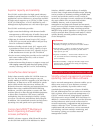
3
Superior capacity and scalability
The GX 550
®
switch offers the high-speed, industry-
standard, optical interfaces essential to core and access
applications such as ATM access, private line and DSL.
A single switch supports up to 156 OC-3/STM-1 ports,
39 OC-12/STM-4 ports, or 9 OC-48/STM-16 ports –
although most deployments use a rich mix of port types.
The GX 550
®
switch also provides:
• Agile connection buffering with advanced traffic
management to efficiently mix all traffic classes and
users on a single network while maintaining QoS
• High rate of switched virtual circuit (SVC) setup –
5,000 SVCs per second and 8 million calls per busy
hour for continued scalability
• Industry-leading virtual circuit (VC) support with
a permanent virtual circuit (PVC) capacity of up to
1.28M simultaneous circuits, SVC capacity of up to
6.4M simultaneous circuits per GX 550 Switch
• Service-aware routing that provides end-to-end QoS
and creates enhanced services, such as virtual
private networks (VPNs)
• Advanced networking features to support secure and
wide-ranging connectivity with closed user groups (CUGs),
security screening, and SVC-to-PVC interworking
Cost-effective data transport
Today’s data networks utilize OC-12/STM-4 rates at
the core, but increasing data transport rates are
quickly making it critical to upgrade to OC-48/STM-16
backbones. As data moves at OC-48/STM-16 speeds
and as ATM switches become more resilient, the
distinction between switching and transmission blurs.
Rather than using a traditional SONET/SDH ring
backbone, you have the option to connect GX 550
®
switches directly to fiber through DWDM equipment
or direct fiber connections. This moves statistical
multiplexing into the transmission facility—giving
you more cost-effective and efficient data transport.
In addition, this streamlined network can help lower
operating costs and speed service provisioning.
Carrier-class MXOS™ Multiservice
Switch Operating Software helps
increase profitability
MXOS™ software supports ATM, FR and IP services
on the CBX 500
®
and GX 550
®
Multiservice WAN
Switches. MXOS™ enables delivery of multiple
services from a single network infrastructure, allowing
service providers to maintain existing profitable data
services and avoid the need for costly overlay IP
networks. It leverages Lucent’s experience in building
the most reliable voice networks and includes
reliability features, such as improved fault
management and improved manual and automatic
service recovery. These features have been adapted to
bring greater reliability to data switching networks.
MXOS™ helps reduce operations costs with pro-active
tools for network data collection and analysis, which
quickly identify potential problems and prevent
service disruptions.
Simplify network management and reduce
operating costs with Navis
®
software
Navis
®
network management software enables you to
deliver new services to your business customers
quickly and profitably. It provides end-to-end,
standards-based management of Lucent IP/MPLS,
FR, and ATM multiservice core and access networks.
Navis software offers exceptional management of a
GX 550
®
switch network, using industry-standard
TCP/IP protocols such as SNMP, TFTP and Telnet. In
addition, a command line interface provides Ethernet
and asynchronous serial console connections for
network monitoring, configuration and performance
statistics collection. Navis
®
software also delivers
sophisticated add-on functions, such as automated
provisioning, real-time statistics monitoring, and
accounting—giving you excellent network
management control.
Key features
• Protocol-independent multiservice switching —
Flexibility to change your service mix to meet demand
• Small footprint — Scale to 25 Gbps full duplex capacity
(32 Gbps for IP/MPLS) per chassis to provide 50/64
Gbps capacity per rack
• Superior availability — Lossless fabric switchover and
1+1 Automatic Protection Switching (APS) provide
proven reliability
• Excellent scalability — High port densities, high virtual
circuit support, and distributed routing and signaling
increase service capacity
Provides ATM-level QoS for all multiservice traffic






